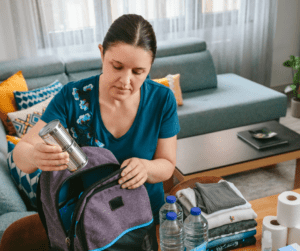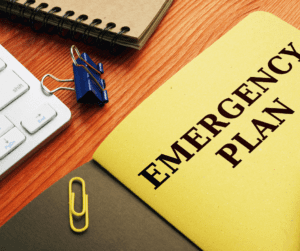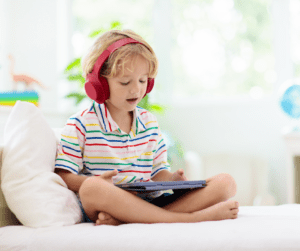Preparing for a Hurricane with a Child with Autism: A Comprehensive Overview
 As hurricane season approaches, it’s important to ensure that your family is prepared for any potential storms. Hurricane preparation is crucial for all families, but it can be especially challenging when a child with autism is involved. In this guide, we will talk through tips that may help your family in the face of an extreme weather event.
As hurricane season approaches, it’s important to ensure that your family is prepared for any potential storms. Hurricane preparation is crucial for all families, but it can be especially challenging when a child with autism is involved. In this guide, we will talk through tips that may help your family in the face of an extreme weather event.
Understanding Your Child’s Needs During a Hurricane
When preparing for a hurricane, it’s important to understand the needs of a child with autism. Kids with autism often have sensory issues, so roaring wind and bright lights from a hurricane can cause distress. Changes to their daily routines and the unpredictability of a hurricane can also increase children’s anxiety and discomfort.
It’s crucial to identify what might stress your child and think of ways to reduce it. For instance, practicing calming techniques or familiarizing your child with the sounds of a storm through controlled exposure in a safe environment might be beneficial. Recognizing and planning for these sensory and emotional challenges before a hurricane can make a big difference in how your child experiences and copes with the event. By tuning into your child’s unique perspective and needs, you can create a more secure and reassuring environment during the uncertain times a hurricane brings.
Creating a Personalized Emergency Plan

Tailoring an emergency plan that fits the needs and preferences of a child with autism is a fundamental step in hurricane preparation. It’s important to make sure they understand and can follow the plan during such a stressful time. Visual aids can be very helpful, like using pictures to show the steps of the emergency plan or making a social story that explains what will happen during a hurricane. This approach helps demystify the process, making it less intimidating for your child.
Additionally, it’s important to equip any emergency responders with critical information about your child’s condition and specific care requirements. Your plan should include a clear and informative profile of your child, covering things like communication preferences, sensory sensitivities, and behavioral triggers. This profile should be easily accessible and shared with anyone who might be assisting your family during the hurricane.
By taking these proactive steps, you can create a sense of preparedness that not only ensures your child’s safety but also contributes to their comfort and well-being during an emergency situation.
Packing an Autism-Friendly Emergency Kit
In crafting an emergency kit tailored for a child with autism, it’s essential to focus on both comfort and practicality. We recommend including:
- Any items that can provide comfort and distraction, such as a few of their most cherished toys or a beloved blanket.
- Sensory items: textured materials, stress balls, or anything that has proven to help your child self-soothe in the past.
- Noise-canceling headphones can be a game-changer in managing the overwhelming sounds of a storm, providing a quiet retreat for sensitive ears.
- Any specialized items your child relies on daily, such as specific snacks that meet dietary restrictions or a tablet loaded with favorite games and apps for both entertainment and educational purposes.
- An adequate supply of any medications your child may need, along with a copy of their prescriptions.
- Any communication aids your child uses to help them express their needs and feelings during this stressful time.
By assembling these items, your emergency kit will not only address basic needs but also provide a sense of familiarity and security amidst the chaos of a hurricane.
Maintaining Communication and Comfort
 During a hurricane, maintaining a clear and reassuring line of communication with a child with autism is essential. This might involve employing strategies tailored to your child’s communication needs. For instance, creating a visual board filled with symbols or pictures that represent different needs or emotions can facilitate expression when words are hard to come by. Additionally, using technology such as tablets or smartphones with communication apps can bridge gaps, especially when power outages are not a concern. Having a battery backup ensures that communication devices are still usable in power outages.
During a hurricane, maintaining a clear and reassuring line of communication with a child with autism is essential. This might involve employing strategies tailored to your child’s communication needs. For instance, creating a visual board filled with symbols or pictures that represent different needs or emotions can facilitate expression when words are hard to come by. Additionally, using technology such as tablets or smartphones with communication apps can bridge gaps, especially when power outages are not a concern. Having a battery backup ensures that communication devices are still usable in power outages.
Offering consistent comfort is also very important. Simple gestures like holding hands, providing gentle reassurance, or engaging in a preferred activity together can be very soothing. It’s beneficial to have a designated ‘comfort zone’ within your home—a familiar, safe space with items that help your child feel secure. Whether it’s a tent filled with soft pillows and blankets or a corner with headphones and calming music, this space can offer a retreat from the sensory overload of the storm outside. Remember, the goal is to foster a sense of safety and security, helping your child navigate the challenges of a hurricane with as much ease as possible.
After the Storm: Returning to Routine
Restoring your child’s familiar schedule is key in the aftermath of a hurricane. The predictability of routine can be comforting for a child with autism, aiding in their recovery from the upheaval. Start by reintroducing regular meal times, bedtimes, and favorite activities as closely as you can to their pre-storm patterns. If routines are disrupted due to the storm, try to create new ones that maintain a sense of structure. For example, if your child’s school is temporarily closed, establish a home-based learning activity at the usual school time. Use visual schedules or timers to help transition between activities smoothly, reducing anxiety about unexpected changes.
Acknowledge and validate your child’s feelings about the storm and its effects, using simple, clear language suited to their level of understanding. Gradually, as you rebuild routines, you will also rebuild your child’s sense of safety and normalcy. Pay close attention to their cues and adjust plans as necessary to meet their evolving needs during this recovery phase.
